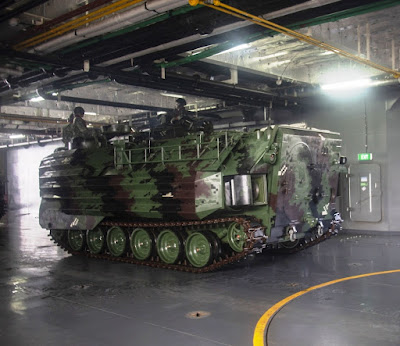U.S. and Philippines Conduct Assault Amphibious Vehicle Subject Matter Expert Exchange
09 September 2019
PMC's Assault Amphibious Vehicle with the new camos (all photos : dvids)
SUBIC BAY, Philippines — U.S. Marines from the 3rd Marine Division, III Marine Expeditionary Force, conducted an Assault Amphibious Vehicle subject matter expert exchange with the Philippine Marine Corps and Navy in order to further develop a shared understanding of amphibious operations. The exchange was conducted in preparation for the annual bilateral military exercise Kamandag 3.
This exchange marks a milestone in the relationship between the U.S. Marine Corps, Philippine Marine Corps, and Philippine Navy and allows for increased opportunities for future interoperability training in the Indo-Pacific region. It is the first time the Philippine Marine Corps launched their AAVs from a Philippine Navy amphibious ship and transited from ship to shore.
1st Lt. Malcolm Dunlop, an AAV platoon commander with the 4th Marine Regiment, participated in the event and reflected on its benefits to the U.S. - Philippine relationship.
“This subject matter expert exchange is an invaluable opportunity for us to coordinate and train with our Philippine Marine Corps and Navy partners for Kamandag 3 and other future operations,” said Dunlop.
The 3rd Marine Division and the Philippine Marine Corps Armor Battalion have been working together on AAV integration for amphibious operations over the past eight years. This process includes events like developing appropriate facilities for the AAVs, conducting training on operating and maintaining the vehicles, and developing standard operating procedures for the vehicle’s employment.
AAVs have a very diverse set of capabilities. They can be used for counter terrorism, mechanized assault, as well as humanitarian assistance operations, explained James Bolt, an exercise planner for III Marine Expeditionary Force, who has been heavily involved in developing the U.S.-Philippine Marine Corps relationships. He went on to describe how AAVs are favored by Philippine and U.S. forces for their ease of naval landings in contested environments and their ability to deploy in the event of a natural disaster.
“Marines are amphibious by nature and this is the capability U.S. Marines are known for,” said Bolt. “This capability for the Philippine Marines will increase our interoperability and ability to work together through the complex nature of amphibious operations in the Indo-Pacific region.”
(DVIDS)
PMC's Assault Amphibious Vehicle with the new camos (all photos : dvids)
SUBIC BAY, Philippines — U.S. Marines from the 3rd Marine Division, III Marine Expeditionary Force, conducted an Assault Amphibious Vehicle subject matter expert exchange with the Philippine Marine Corps and Navy in order to further develop a shared understanding of amphibious operations. The exchange was conducted in preparation for the annual bilateral military exercise Kamandag 3.
This exchange marks a milestone in the relationship between the U.S. Marine Corps, Philippine Marine Corps, and Philippine Navy and allows for increased opportunities for future interoperability training in the Indo-Pacific region. It is the first time the Philippine Marine Corps launched their AAVs from a Philippine Navy amphibious ship and transited from ship to shore.
1st Lt. Malcolm Dunlop, an AAV platoon commander with the 4th Marine Regiment, participated in the event and reflected on its benefits to the U.S. - Philippine relationship.
“This subject matter expert exchange is an invaluable opportunity for us to coordinate and train with our Philippine Marine Corps and Navy partners for Kamandag 3 and other future operations,” said Dunlop.
The 3rd Marine Division and the Philippine Marine Corps Armor Battalion have been working together on AAV integration for amphibious operations over the past eight years. This process includes events like developing appropriate facilities for the AAVs, conducting training on operating and maintaining the vehicles, and developing standard operating procedures for the vehicle’s employment.
AAVs have a very diverse set of capabilities. They can be used for counter terrorism, mechanized assault, as well as humanitarian assistance operations, explained James Bolt, an exercise planner for III Marine Expeditionary Force, who has been heavily involved in developing the U.S.-Philippine Marine Corps relationships. He went on to describe how AAVs are favored by Philippine and U.S. forces for their ease of naval landings in contested environments and their ability to deploy in the event of a natural disaster.
(DVIDS)






0 Response to "U.S. and Philippines Conduct Assault Amphibious Vehicle Subject Matter Expert Exchange"
Post a Comment